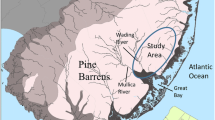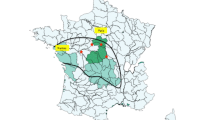Abstract
Brain, livers, and subcutaneous fat of 50 Cormorants (Phalacrocorax carbo sinensis, Blumenbach 1798) were analyzed for 6 PCB congeners. The birds had been shot in autumn 1985 and 1986 in Schleswig-Holstein, FRG. Subcutaneous fat was the highest contaminated tissue, while brain had accumulated the lowest concentrations. An accumulation by age was statistically significant between the groups of 1st year/2nd year birds and after 2nd year birds. There were no differences evident between sex and between weight groups. Pooled samples were analyzed by GC-MS; 61 congeners could be identified in adipose tissue, 54 in liver, and 49 in brain. 18 congeners were quantified in spotchecks, and some samples were analyzed by multidimensional gaschromatography. In comparison to fish they consume, the fat of cormorants was concentrated with PCBs 10–100 times more than marine fish, and 100–1,000 times more than freshwater fish. This species is a suitable bioindicator for PCBs.
Similar content being viewed by others
References
Ballschmiter K, Zeil M (1980) Analysis of polychlorinated biphenyls (PCB) by glass capillary gas chromatography. Fresenius Z Anal Chem 302:20–21
Biessmann A (1981) Accumulation of polychlorinated biphenyls in steroid-genic tissue of gonads and adrenals in Japanese quail. Arch Environ Contam Toxicol 10:653–662
Brunn H (1984) Elimination and distribution of 2,2′,4,5′-tetrachlorobiphenyl in laying hens. Food Chem Toxicol 22(8):689–691
Dowd PF, Mayfield GU, Coulon DP, Graves JG, Newsome JD (1985) Organochlorine residues in animals from three Louisiana watersheds in 1978 and 1979. Bull Environ Contam Toxicol 34:832–841
Duinker JC, Schulz DE, Patrick G (1988) Multidimensional gas chromatography with electron capture detection for the determination of toxic congeners in polychlorinated biphenyl mixtures. Anal Chem 60:29–33
El Dib MA, Badawy MI (1985) Organochlorine insecticides and PCBs in water, sediment, and fish from the Mediterranean Sea. Bull Environ Contam Toxicol 34:370–374
El Nabawi A, Heinzow B, Kruse H (1987) Residue levels of organochlorine chemicals and polychlorinated biphenyls in fish from Alexandria region, Egypt. Arch Environ Contam Toxicol 16:689–696
Frank R, Lumsden H, Barr JF, Braun HE (1983) Residues of organochlorine insecticides, industrial chemicals, and mercury in eggs and tissue taken from healthy and emaciated common loons, Ontario, Canada. Arch Environ Contam Toxicol 12:641–654
Greichus YA, Greichus A, Draayer HA, Marshall B (1978) Insecticides, polychlorinated biphenyls, and metals in African lake ecosystem. II. Lake McIlwaine, Rhodesia. Bull Environ Contam Toxicol 19:444–453
Hansen LG, Tuinstra LGMT, Kan CA, Strik JJTWA, Koeman JH (1983) Accumulation of chlorobiphenyls in chicken fat and liver after feeding Aroclor 1254 directly or fat from swine fed Aroclor 1254. J Agric Food Chem 31:354–260
Heidmann WA, Beyerbach M, Böckelmann W, Büthe A, Knüwer H, Peterat B, Rüssel-Sinn HA (1987) Chlorierte Kohlenwasserstoffe und Schwermetalle in tot an der deutschen Nordseeküste aufgefundenen Seevögeln. Die Vogelwarte 34:126–133
Huschenbeth H (1978) in DGF (1978) Deutsche Forschungsgemeinschaft. Rückstände in Fischen—Situation und Bewertung. Boppard
Jensen S, Johnels AG, Olsen M, Westermark T (1970) The avifauna of Sweden as indicators of environmental contamination with mercury and chlorinated hydrocarbons. Proceedings of the XVth International Ornithology Congress, Den Haag, 1970
Kim KS, Pastel MJ, Kim JS, Stone WB (1984) Levels of polychlorinated biphenyls, DDE, and mirex in waterfowl collected in New York State, 1979–1980. Arch Environ Contam Toxicol 13:373–381
Köhler A, Harms U, Luckas B (1986) Accumulation of organochlorines and mercury in flounder—an approach to pollution assessments. Helgoländer Meeresunters. 40:431–440
Koeman JH, Van Velzen-Blad HCW, De Vries R, Vos JG (1973) Effects of PCB and DDE in cormorants and evaluation of PCB residues from an experimental study. J Reprod Fert Suppl 19:353–364
Luckas B, Harms U (1987) Characteristic levels of chlorinated hydrocarbons and trace metals in fish from coastal waters of North and Baltic Sea. Int J Environ Anal Chem 29:215–225
Matthews HB, Dedrick RL (1984) Pharmacokinetics of PCBs. Ann Rev Pharmacol Toxicol 24:85
Menke T (1986) Untersuchungen zur Biologie und Bestandsentwicklung des Kormorans (Phalacrocorax carbo sinensis) in Schleswig-Holstein 1984–1986. Thesis Universität Kiel
- (1985) Zur Situation des Kormorans (Phalacrocorax carbo sinensis) in Schleswig-Holstein. In: Larsson T (ed) Cormorants in North Europe. Proceedings from the meeting in Falstebro, Sweden, Sept. 1985. Printed by National Environmental Protection Board 1986: p 55
Niethammer KB, White DB, Basket TS, Sayre MW (1984) Presence and biomagnification of organochlorine chemical residues in Oxbow Lakes of Northeastern Louisiana. Arch Environ Contam Toxicol 13:63–74
Parslow JLF, Jefferies DJ (1973) Relationship between organochlorine residues in livers and whole bodies of guillemots. Environ Pollut 5:87–101
Safe S, Bandiera T, Sawyer L, Robertson L, Safe L, Parkinson A, Thomas PE, Ryan DE, Reik LM, Levin W, Denomme MA, Fujita T (1985) PCBs: Structure-function relationships and mechanism of action. Environ Health Perspect 60:47–56
Scharenberg W (1991) Prefledging Terns (Sterna paradisaea, Sterna hirundo) as bioindicators for organochlorine residues in the German Wadden Sea. Arch Environ Contam Toxicol 21:102–105
Schulz DE, Patrick G, Duinker JC (1989) Complete characterization of polychlorinated biphenyl congeners in commercial Aroclor® and Clophen® mixtures by multidimensional gas chromatography-electron capture detection. Environ Sci Technol 23:852–859
Stan HJ (1988) Automatische Rückstandsanalyse von Pflanzenbehandlungsmitteln mit Hilfe der zweidimensionalen Kapillargaschromatographie. Lebensmittelchem Gerichtl Chem 42:31–36
Tanabe S (1988) PCB problems in the future: Foresight from current knowledge. Environ Pollut 50:5–28
Van den Berg M, Blank F, Heersmans C, Wagenaar H, Olie K (1987) Presence of polychlorinated dibenzo-p-dioxins and polychlorinated dibenzofurans in fish-eating birds and fish from the Netherlands. Arch Environ Contam Toxicol 16:149–158
Van Velzen AC, Stiles WB, Stickel LF (1972) Lethal mobilisation of DDT by cowbirds. J Wildl Manage 36:733–739
Walker CH (1983) Pesticides and birds—mechanism of selective toxicity. Agric Ecol Environ 9:211–226
Zell M, Ballschmiter K (1980) Baseline studies of the global pollution (III Trace analysis of polychlorinated biphenyl (PCB) by ECD glass capillary gas chromatography in environmental samples of different tropic levels). Fresenius Z Anal Chem 304:337–349
Author information
Authors and Affiliations
Rights and permissions
About this article
Cite this article
Scharenberg, W. Cormorants (Phalacrocorax carbo sinensis) as bioindicators for polychlorinated biphenyls. Arch. Environ. Contam. Toxicol. 21, 536–540 (1991). https://doi.org/10.1007/BF01183875
Received:
Issue Date:
DOI: https://doi.org/10.1007/BF01183875




